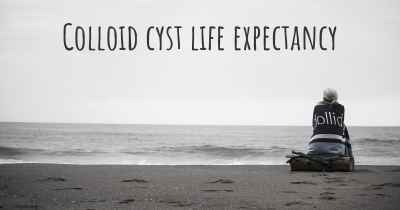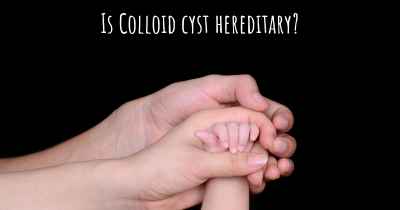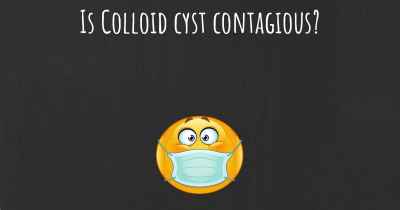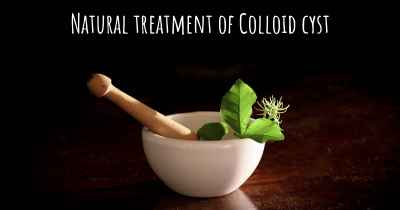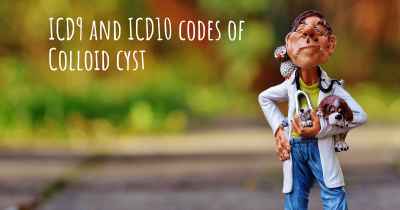20
What are the latest advances in Colloid cyst?
Here you can see the latest advances and discoveries made regarding Colloid cyst.
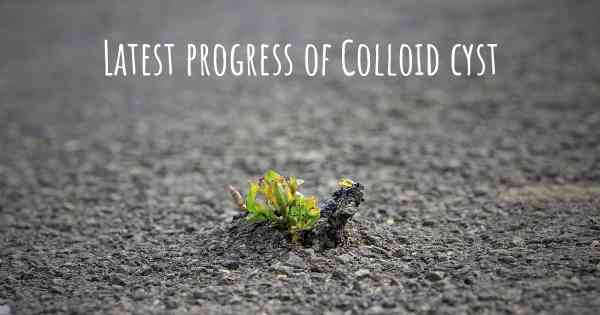
Better surgery technique
Posted Aug 14, 2017 by Jane Mcneill 2100
Neuroendoscopy, has been recognised as a viable and safe alternative to microsurgery for the treatment of third ventricle colloid cyst.
Controversy remains as to which is superior 1).
Powell et al. are credited with the first successful endoscopic aspiration of the colloid cysts. 2)
Less invasive endoscopic techniques have employed rigid endoscopes with single or dual working channels.
The increased range of viewing angles of the endoscope within the cylinder of access maintained by the tubular retractor facilitates resection of the cyst through a smaller opening 3).
Entry point and trajectory
An optimal entry point and trajectory for endoscopic colloid cyst (ECC) resection helps to protect important neurovascular structures. There is a large discrepancy in the entry point and trajectory in the neuroendoscopic literature.
The endoscopic approach to colloid cysts of the third ventricle is usually performed through the foramen of Monro. However, this route does not provide adequate visualization of the cyst attachment on the tela choroidea. The combined endoscopic transforaminal-transchoroidal approach (ETTA), providing exposure of the entire cyst and a better visualization of the tela choroidea, could increase the chances of achieving a complete cyst resection 4).
Using a more anterior approach, it is easier to reach the roof of the cyst and its possible adherences with the tela choroidea 5) 6).
Trajectory views from MRI or CT scans used for cranial image guidance in 39 patients who had undergone ECC resection between July 2004 and July 2010 were retrospectively evaluated. A target point of the colloid cyst was extended out to the scalp through a trajectory carefully observed in a 3D model to ensure that important anatomical structures were not violated. The relation of the entry point to the midline and coronal sutures was established. Entry point and trajectory were correlated with the ventricular size. Results The optimal entry point was situated 42.3 ± 11.7 mm away from the sagittal suture, ranging from 19.1 to 66.9 mm (median 41.4 mm) and 46.9 ± 5.7 mm anterior to the coronal suture, ranging from 36.4 to 60.5 mm (median 45.9 mm). The distance from the entry point to the target on the colloid cyst varied from 56.5 to 78.0 mm, with a mean value of 67.9 ± 4.8 mm (median 68.5 mm). Approximately 90% of the optimal entry points are located 40-60 mm in front of the coronal suture, whereas their perpendicular distance from the midline ranges from 19.1 to 66.9 mm. The location of the “ideal” entry points changes laterally from the midline as the ventricles change in size.
The results suggest that the optimal entry for ECC excision be located at 42.3 ± 11.7 mm perpendicular to the midline, and 46.9 ± 5.7 mm anterior to the coronal suture, but also that this point differs with the size of the ventricles. Intraoperative stereotactic navigation should be considered for all ECC procedures whenever it is available. The entry point should be estimated from the patient’s own preoperative imaging studies if intraoperative neuronavigation is not available. An estimated entry point of 4 cm perpendicular to the midline and 4.5 cm anterior to the coronal suture is an acceptable alternative that can be used in patients with ventriculomegaly 7).
Complications
Intraventricular extruded colloid fragments can occur after endoscopic resection, with the possible risk demonstrated as cyst hypointensity on preoperative T2-weighted images. The finding does not seem to result in any clinical morbidity, and radiographic involution is the rule. Migratory capacity, however, does exist and justifies a more frequent imaging surveillance schedule and consideration for removal 8).
A patient presented with headaches and was found to have a colloid cyst in the third ventricle and ventriculomegaly. The patient underwent endoscopic colloid cyst resection and third ventriculostomy without incidence. Prior to emergence, a blown right pupil was acutely noted, and bright red blood emanated from the ventricular drain that was routinely placed in the endoscopy tract at the conclusion of the procedure. CT angiography demonstrated active extravasation from the pre-pontine cistern into the third ventricle and subarachnoid space. Emergency DSA confirmed active extravasation from an avulsed thalamoperforator arising from the proximal right P1 posterior cerebral artery, which was immediately embolized without incident 9).
Case series
2016
27 consecutive patients with symptomatic primary and recurrent colloid cysts. All cysts were removed via a neuroendoscope through a rostral transfrontal, transforaminal approach. The endoscope was supported by an additional cannula fixed in the stereotactic frame. Both tools were inserted into one lateral ventricle through two separate burr holes using stereotactic guidance.
The median operating time was 135 minutes. All cysts were removed completely, and no mortality or permanent complications related to surgery occurred. The mean time of observation was 43.5 months (range, 3-78 months), and no clinical or radiologic recurrences were observed. One patient with a history of an infected ventriculoperitoneal shunt did not improve after cyst removal, but improved after subsequent reimplantation of the shunt. In all other cases, symptoms resolved (67%) or decreased (30%). Cognitive functions improved or remained unchanged in all 10 elective cases examined neuropsychologically before and after surgery.
The technique describe for removal of colloid cysts are safe and effective, even for recurrent cases, and they provide 100% total resection, favorable cognitive outcomes, low risk of recurrence, and low risk of morbidity. The disadvantages of this method are a longer time for surgery and the need for more complex instrumentation compared with conventional endoscopic resection 10).
2014
56 patients were reviewed. Surgeries involved an anterolateral neuroendoscopic technique. Patients were followed postoperatively for an average of 14.9 months. Patients were also interviewed regarding their preoperative symptoms, resolution of symptoms postoperatively, and their degree of satisfaction.
The median operative time was 82 minutes, and the median duration of hospital stay was 5 days. During surgery, the ventricles were explored for residual cyst wall or cyst content, and none were encountered. On immediate postoperative imaging, cyst recurrence was not noted for any patient, and only 1 patient has had evidence of recurrence on long-term follow-up. Various preoperative symptoms were described by patients; depending on the specific symptoms, 70%-100% resolution of symptoms was shown after surgery. Along with clinical follow-up, patients were interviewed regarding their perception of surgery and recovery. Of the patients contacted, 100% reported satisfaction with the surgery, and 91% noted satisfaction with their recovery. Reported complications included memory loss, infection, deep vein thrombosis, and postoperative hematoma. There were 2 perioperative deaths (3.5%) related to surgery.
Neuroendoscopic colloid cyst resection can reliably achieve complete lesion removal with short operative times. In addition, there is a high level of reported patient satisfaction. This is till 2014 the largest case series of neuroendoscopic colloid cyst resections from a single surgeon 11).
24 patients with colloid cysts of the third ventricle treated in our department between October 2001 and January 2013 using an endoscopic approach. Clinical presentation, preoperative radiological findings, endoscopic technique employed, and complications were assessed in all patients. The mean length of patient follow-up was 5.16 years. The most common symptom was headache (75%). The average size of the resected colloid cysts was 16.25 mm, the maximum diameter measured in cranial magnetic resonance imaging. Resection was transforaminal in 16 cases (66.7%), transchoroidal in 7 (29.17%), and transseptal in 1; macroscopically complete resection was achieved in 23 of 24 procedures (95.8%). Complications included three intraventricular hemorrhages, four memory deficits (two of them transient), one case of temporary potomania, two soft tissue infections, and one meningitis. There were no statistically significant differences between the route of resection and number of complications. The Glasgow Outcome Scale at 1 year after surgery was 5 in 82.6% of the patients. A transventricular endoscopic approach allows macroscopically complete resection of third ventricle colloid cysts in most cases. The option of opening the choroidal fissure (transventricular-transchoroidal approach) during the procedure can address third ventricle colloid cysts that do not emerge sufficiently through the foramen of Monro without increasing procedure-related morbidity 12).
29 patients who underwent surgery by a variation of the standard worldwide implemented endoscopic technique. Using a more anterior approach, it is easier to reach the roof of the cyst, its possible adherences with the tela choroidea, plexus, and the internal cerebral veins. The described approach has shown to be safe, quick, and very effective with a total cyst removal rate of 86.2% 13).
24 patients.Preoperative computed tomography (CT) scans revealed hydrocephalus in all the patients. Postoperative magnetic resonance imaging (MRI) was done in all cases.
Age ranged from 16 to 57 years. There were 16 male and 8 female patients. The diameter of the cyst varied from 14 to 24 mm. Operating time ranged from 90 to 156 minutes. Total resection was achieved in 21 patients. All patients with subtotal excision underwent coagulation of residual cyst wall. The follow-up period ranged from 6 to 78 months (mean, 37 months). None of the patients developed any symptoms at 26, 31, and 39 months of follow-up. Preoperative symptoms disappeared in all the patients except for memory disorders and seizures in one patient each. No residual cyst was observed on the postoperative MRIs in 21 patients. Hospital stay was 4 to 10 days (median, 6 days). No endoscopic operation was converted into an open resection.
Endoscopic excision of a colloid cyst is an effective and safe alternate method. Although the follow-up time was short, residual cyst wall remained asymptomatic without any evidence of growth after subtotal excision and coagulation of wall 14).
2013
Of 22 patients, near-total resection was obtained in 95%. In 3 cases, a very small, radiographically occult residual was left. Complete cyst wall resection was therefore obtained in 18 (82%). There were no cases of recurrence at follow-up in any patient. No patients required craniotomy or underwent re-resection. Fifteen of 16 (94%) patients with long-term clinical follow-up remained stable or improved.
High rates of complete colloid cyst resection, with low morbidity, are possible with an anterolateral endoscopic approach with dual-instrument technique. These results support the findings of other endoscopists that show how technical modifications to traditional endoscopic approaches can produce favorable results 15).
Sixteen patients (8 female) underwent attempted endoscopic removal of a colloid cyst in the absence of ventriculomegaly. Surgery was technically successful in 15 patients. The cyst was removed completely in 13 of patients. Short-term memory loss was initially present in 3 patients and completely resolved in all but 1 patient who had presented with short-term memory loss. Temporary complications occurred in 2 patients.
Normal-size ventricles are not a contraindication to endoscopic removal of third ventricular colloid cysts. Complication rates are at least comparable to those of patients with ventriculomegaly or to those undergoing open microsurgical resection 16).
Sixty-five consecutive patients and 67 procedures for endoscopic resection of colloid cysts from 1995 to 2011 were reviewed. Degree of resection was based on intraoperative assessment and postoperative magnetic resonance imaging (MRI). Recurrence rates were compared between patients with complete resection those with coagulated cyst remnants.
Data analysis was performed of 56 patients and 58 procedures, with no follow-up in 9 patients. All patients had MRI-defined complete resection. On intraoperative assessment, 9 procedures had coagulated remnants and 45 procedures had complete resection (4 data unknown). The overall recurrence rate was 6.89% (4/58), 33.3% (3/9) with cyst remnants, and 2.2% (1/45) with total resection (P = .0124). Maximum follow-up was 144 months (mean, 40.4 months). Mean follow-up was 66.0 months for cyst remnant cases, and 33.5 months for totally resected cases. There was no mortality or permanent morbidity. Transient morbidity included memory deficit (n = 2), aseptic meningitis (n = 1), and local wound infection (n = 1).
Endoscopic colloid cyst resection results in a low overall recurrence rate. Immediate postoperative MRI was insufficient for assessing degree of resection and was a poor predictor of recurrence. Ablation of cyst remnants rather than total removal is associated with a significantly higher rate of recurrence. The primary goal of endoscopic surgery should, therefore, be removal of all cyst contents and wall remnants 17).
2006
18 patients between 1996 and 2006. All patients were operated through a single burr hole at Kocher’s point using a rigid endoscope with a single working channel. The anatomical variations of the cyst and the foramen of Monro dictated the use of the transforaminal approach, the transseptal interforniceal approach or both.
There were no mortalities or significant morbidities. The operative time ranged between 90 to 240 minutes (with a mean of 133 minutes). Five patients (27.7%) developed remediable postoperative chemical meningitis successfully controlled with steroids. Postoperative transient memory disturbance was observed in 3 patients (16.7%). One patient had a postoperative CSF leak that stopped spontaneously. Aspiration of the cyst’s contents showed variable degrees of resistance to aspiration. The period of follow-up ranged between 5 months to 8 years and 3 months (mean: 4 years and 2 months). None of our patients showed radiological evidence of cyst recurrence during the follow-up period.
Through a single right pre-coronal burr hole at Kocher’s point, several endoscopic manoeuvres can be done. These include aspiration of the contents or its piecemeal removal, combined balloon squeeze and aspiration, foraminoplasty, pellucidotomy, coagulation of cyst capsule and ETV. The choice of the appropriate approach is largely dependent on the location of the cyst and the shape of the foramen of Monro. Coronal MRI may aid in preoperative evaluation of the tucked up retroforaminal growth of the cyst. We had no recurrence in our series with a follow-up reaching more than 8 years. This could be attributed to both the marsupialization and coagulation done for the remaining cyst capsule 18).
2000
Twelve patients underwent 14 endoscopic operations in attempts to treat their colloid cysts. All patients were symptomatic, with headache being the most common complaint (8 of 12 patients). Six patients in this series exhibited enlarged ventricles associated with their colloid cysts. Using rigid endoscopes of < or =3.5-mm diameter, the cysts were inspected and fenestrated. Both hard and soft cyst contents were evacuated, and then the walls of the cysts were coagulated inside and outside. External ventriculostomy tubes were usually placed. Technical obstacles to successful completion of endoscopic colloid cyst surgery are discussed.
For 11 of the 12 patients, the colloid cysts could be treated via an endoscopic approach. The mean follow-up time was 173 weeks, and the median follow-up time was 125 weeks. For the 12th patient, bilateral scarring of the foramina of Monro precluded direct surgery; therefore, a septostomy was performed and a ventriculoperitoneal shunt was placed 19).
1999
Fifteen patients with a radiological diagnosis of colloid cysts were given the option of undergoing either endoscopic surgery or craniotomy. The average tumor size was 1.43 cm. Fourteen patients underwent planned endoscopic resections, and a craniotomy was performed initially in one patient.
Entire tumor resection was achieved with the endoscope in 12 patients (86%). A craniotomy was required for two colloid cysts that could not be resected endoscopically. In total, complete radiographic resections were achieved in 14 patients (93%). There were no permanent complications, although postoperative deficits included short-term memory loss and hemiparesis, each in one patient.
Rigid endoscopy affords good optical resolution, high magnification, and excellent illumination. Total or near total resection of colloid cysts should be the goal for all patients and can be achieved using the rigid endoscope, with little morbidity, shortened operative time, reduced length of stay, and resolution of symptoms. Although long-term follow-up is needed, we think that endoscopy should be considered as a primary treatment for most patients 20).
1998
The presenting symptoms of our patients (10 men and 5 women) were intermittent headache (10 patients), nausea (3 patients), short-term memory loss (4 patients), coma (2 patients), gait disturbance (3 patients), blurred vision (2 patients), and mental status changes (3 patients). The sizes of the cysts ranged from 4 to 50 mm (median, 22.93 mm). Depending on the radiological appearance, the procedure was performed via a right (10 patients) or left (5 patients) precoronal burr hole. A rigid neuroendoscope was used. Initial stereotactic placement of the neuroendoscope was used in two patients who had moderate hydrocephalus. In the other patients, hand-guided endoscopy was performed using an articulated arm. The cysts were perforated with a needle. The opening was enlarged with microscissors. The cyst material was aspirated, and the remaining capsule was coagulated.
The average follow-up was 15.26 months (range, 1-28 mo). Total aspiration of the cysts was achieved in 12 patients, as revealed by normal postoperative magnetic resonance imaging. Control magnetic resonance imaging revealed residual cysts in three patients. One patient presented with an asymptomatic recurrence at 1 year. Resolution of the symptoms was obtained in all patients except for two of the four patients with preoperative memory deficit (improvement without complete recovery). There was no mortality or morbidity.
These results show that endoscopy is a safe and promising percutaneous technique for the treatment of colloid cysts of the third ventricle. Longer follow-up is, however, still required 21).
The surgical technique for the endoscopic evacuation of colloid cysts of the third ventricle in 13 patients is described. The authors conclude that endoscopic resection of these lesions is a useful addition to the current surgical repertoire and a viable alternative to stereotactic aspiration or open craniotomy 22).
1)
Connolly ID, Johnson E, Lamsam L, Veeravagu A, Ratliff J, Li G. Microsurgical vs. Endoscopic Excision of Colloid Cysts: An Analysis of Complications and Costs Using a Longitudinal Administrative Database. Front Neurol. 2017 Jun 9;8:259. doi: 10.3389/fneur.2017.00259. eCollection 2017. PubMed PMID: 28649225; PubMed Central PMCID: PMC5465269.
2)
Powell MP, Torrens MJ, Thomson JL, Horgan JG. Isodense colloid cysts of the third ventricle: a diagnostic and therapeutic problem resolved by ventriculoscopy. Neurosurgery. 1983 Sep;13(3):234-7. PubMed PMID: 6621836.
3)
Ajlan AM, Kalani MA, Harsh GR. Endoscopic transtubular resection of a colloid cyst. Neurosciences (Riyadh). 2014 Jan;19(1):43-6. PubMed PMID: 24419449.
4)
Iacoangeli M, di Somma LG, Di Rienzo A, Alvaro L, Nasi D, Scerrati M. Combined endoscopic transforaminal-transchoroidal approach for the treatment of third ventricle colloid cysts. J Neurosurg. 2014 Jun;120(6):1471-6. doi: 10.3171/2014.1.JNS131102. Epub 2014 Mar 7. PubMed PMID: 24605835.
5)
Chibbaro S, Champeaux C, Poczos P, Cardarelli M, Di Rocco F, Iaccarino C, Servadei F, Tigan L, Chaussemy D, George B, Froelich S, Kehrli P, Romano A. Anterior trans-frontal endoscopic management of colloid cyst: an effective, safe, and elegant way of treatment. Case series and technical note from a multicenter prospective study. Neurosurg Rev. 2014 Apr;37(2):235-41; discussion 241. doi: 10.1007/s10143-013-0508-4. Epub 2013 Dec 19. PubMed PMID: 24352893.
6)
Nasi D, Iaccarino C, Romano A. Anterior trans-frontal endoscopic resection of third-ventricle colloid cyst: how I do it. Acta Neurochir (Wien). 2017 Jun;159(6):1049-1052. doi: 10.1007/s00701-017-3149-5. Epub 2017 Apr 4. PubMed PMID: 28378097.
7)
Rangel-Castilla L, Chen F, Choi L, Clark JC, Nakaji P. Endoscopic approach to colloid cyst: what is the optimal entry point and trajectory? J Neurosurg. 2014 Oct;121(4):790-6. doi: 10.3171/2014.5.JNS132031. Epub 2014 Jun 13. PubMed PMID: 24926648.
8)
Abdel Latif AM, Souweidane MM. Extruded contents of colloid cysts after endoscopic removal. J Neurosurg. 2016 Sep;125(3):570-5. doi: 10.3171/2015.6.JNS142676. Epub 2016 Jan 8. PubMed PMID: 26745480.
9)
Turner RD, Chaudry I, Turk A, Spiotta A. Onyx embolization of an avulsed thalamoperforator following endoscopic colloid cyst and lamina terminalis fenestration. J Neurointerv Surg. 2014 Jul 25. pii: neurintsurg-2014-011292. doi: 10.1136/neurintsurg-2014-011292.rep. [Epub ahead of print] PubMed PMID: 25063695.
10)
Birski M, Birska J, Paczkowski D, Furtak J, Rusinek M, Rudas M, Harat M. Combination of Neuroendoscopic and Stereotactic Procedures for Total Resection of Colloid Cysts with Favorable Neurological and Cognitive Outcomes. World Neurosurg. 2016 Jan;85:205-14. doi: 10.1016/j.wneu.2015.08.080. Epub 2015 Sep 5. PubMed PMID: 26348564.
11)
Sribnick EA, Dadashev VY, Miller BA, Hawkins S, Hadjipanayis CG. Neuroendoscopic colloid cyst resection: a case cohort with follow-up and patient satisfaction. World Neurosurg. 2014 Mar-Apr;81(3-4):584-93. doi: 10.1016/j.wneu.2013.12.006. Epub 2013 Dec 22. PubMed PMID: 24368424.
12)
Ibáñez-Botella G, Domínguez M, Ros B, De Miguel L, Márquez B, Arráez MA. Endoscopic transchoroidal and transforaminal approaches for resection of third ventricular colloid cysts. Neurosurg Rev. 2014 Apr;37(2):227-34; discussion 234. doi: 10.1007/s10143-014-0529-7. Epub 2014 Feb 14. PubMed PMID: 24526368.
13)
Chibbaro S, Champeaux C, Poczos P, Cardarelli M, Di Rocco F, Iaccarino C, Servadei F, Tigan L, Chaussemy D, George B, Froelich S, Kehrli P, Romano A. Anterior trans-frontal endoscopic management of colloid cyst: an effective, safe, and elegant way of treatment. Case series and technical note from a multicenter prospective study. Neurosurg Rev. 2014 Apr;37(2):235-41; discussion 241. doi: 10.1007/s10143-013-0508-4. Epub 2013 Dec 19. PubMed PMID: 24352893.
14)
Yadav YR, Parihar V, Pande S, Namdev H. Endoscopic management of colloid cysts. J Neurol Surg A Cent Eur Neurosurg. 2014 Sep;75(5):376-80. doi: 10.1055/s-0033-1343984. Epub 2013 May 22. PubMed PMID: 23700169.
15)
Wilson DA, Fusco DJ, Wait SD, Nakaji P. Endoscopic resection of colloid cysts: use of a dual-instrument technique and an anterolateral approach. World Neurosurg. 2013 Nov;80(5):576-83. doi: 10.1016/j.wneu.2012.07.014. Epub 2012 Jul 28. PubMed PMID: 22850283.
16)
Wait SD, Gazzeri R, Wilson DA, Abla AA, Nakaji P, Teo C. Endoscopic colloid cyst resection in the absence of ventriculomegaly. Neurosurgery. 2013 Sep;73(1 Suppl Operative):ons39-46; ons46-7. doi: 10.1227/NEU.0b013e3182870980. PubMed PMID: 23334281.
17)
Hoffman CE, Savage NJ, Souweidane MM. The significance of cyst remnants after endoscopic colloid cyst resection: a retrospective clinical case series. Neurosurgery. 2013 Aug;73(2):233-7; discussion 237-9. doi: 10.1227/01.neu.0000430300.10338.71. PubMed PMID: 23624411.
18)
Zohdi A, El Kheshin S. Endoscopic approach to colloid cysts. Minim Invasive Neurosurg. 2006 Oct;49(5):263-8. PubMed PMID: 17163338.
19)
Rodziewicz GS, Smith MV, Hodge CJ Jr. Endoscopic colloid cyst surgery. Neurosurgery. 2000 Mar;46(3):655-60; discussion 660-2. PubMed PMID: 10719862.
20)
King WA, Ullman JS, Frazee JG, Post KD, Bergsneider M. Endoscopic resection of colloid cysts: surgical considerations using the rigid endoscope. Neurosurgery. 1999 May;44(5):1103-9; discussion 1109-11. PubMed PMID: 10232544.
21)
Decq P, Le Guerinel C, Brugières P, Djindjian M, Silva D, Kéravel Y, Melon E, Nguyen JP. Endoscopic management of colloid cysts. Neurosurgery. 1998 Jun;42(6):1288-94; discussion 1294-6. PubMed PMID: 9632187.
22)
Abdou MS, Cohen AR. Endoscopic treatment of colloid cysts of the third ventricle. Technical note and review of the literature. J Neurosurg. 1998 Dec;89(6):1062-8. Review. PubMed PMID: 9833841.
Controversy remains as to which is superior 1).
Powell et al. are credited with the first successful endoscopic aspiration of the colloid cysts. 2)
Less invasive endoscopic techniques have employed rigid endoscopes with single or dual working channels.
The increased range of viewing angles of the endoscope within the cylinder of access maintained by the tubular retractor facilitates resection of the cyst through a smaller opening 3).
Entry point and trajectory
An optimal entry point and trajectory for endoscopic colloid cyst (ECC) resection helps to protect important neurovascular structures. There is a large discrepancy in the entry point and trajectory in the neuroendoscopic literature.
The endoscopic approach to colloid cysts of the third ventricle is usually performed through the foramen of Monro. However, this route does not provide adequate visualization of the cyst attachment on the tela choroidea. The combined endoscopic transforaminal-transchoroidal approach (ETTA), providing exposure of the entire cyst and a better visualization of the tela choroidea, could increase the chances of achieving a complete cyst resection 4).
Using a more anterior approach, it is easier to reach the roof of the cyst and its possible adherences with the tela choroidea 5) 6).
Trajectory views from MRI or CT scans used for cranial image guidance in 39 patients who had undergone ECC resection between July 2004 and July 2010 were retrospectively evaluated. A target point of the colloid cyst was extended out to the scalp through a trajectory carefully observed in a 3D model to ensure that important anatomical structures were not violated. The relation of the entry point to the midline and coronal sutures was established. Entry point and trajectory were correlated with the ventricular size. Results The optimal entry point was situated 42.3 ± 11.7 mm away from the sagittal suture, ranging from 19.1 to 66.9 mm (median 41.4 mm) and 46.9 ± 5.7 mm anterior to the coronal suture, ranging from 36.4 to 60.5 mm (median 45.9 mm). The distance from the entry point to the target on the colloid cyst varied from 56.5 to 78.0 mm, with a mean value of 67.9 ± 4.8 mm (median 68.5 mm). Approximately 90% of the optimal entry points are located 40-60 mm in front of the coronal suture, whereas their perpendicular distance from the midline ranges from 19.1 to 66.9 mm. The location of the “ideal” entry points changes laterally from the midline as the ventricles change in size.
The results suggest that the optimal entry for ECC excision be located at 42.3 ± 11.7 mm perpendicular to the midline, and 46.9 ± 5.7 mm anterior to the coronal suture, but also that this point differs with the size of the ventricles. Intraoperative stereotactic navigation should be considered for all ECC procedures whenever it is available. The entry point should be estimated from the patient’s own preoperative imaging studies if intraoperative neuronavigation is not available. An estimated entry point of 4 cm perpendicular to the midline and 4.5 cm anterior to the coronal suture is an acceptable alternative that can be used in patients with ventriculomegaly 7).
Complications
Intraventricular extruded colloid fragments can occur after endoscopic resection, with the possible risk demonstrated as cyst hypointensity on preoperative T2-weighted images. The finding does not seem to result in any clinical morbidity, and radiographic involution is the rule. Migratory capacity, however, does exist and justifies a more frequent imaging surveillance schedule and consideration for removal 8).
A patient presented with headaches and was found to have a colloid cyst in the third ventricle and ventriculomegaly. The patient underwent endoscopic colloid cyst resection and third ventriculostomy without incidence. Prior to emergence, a blown right pupil was acutely noted, and bright red blood emanated from the ventricular drain that was routinely placed in the endoscopy tract at the conclusion of the procedure. CT angiography demonstrated active extravasation from the pre-pontine cistern into the third ventricle and subarachnoid space. Emergency DSA confirmed active extravasation from an avulsed thalamoperforator arising from the proximal right P1 posterior cerebral artery, which was immediately embolized without incident 9).
Case series
2016
27 consecutive patients with symptomatic primary and recurrent colloid cysts. All cysts were removed via a neuroendoscope through a rostral transfrontal, transforaminal approach. The endoscope was supported by an additional cannula fixed in the stereotactic frame. Both tools were inserted into one lateral ventricle through two separate burr holes using stereotactic guidance.
The median operating time was 135 minutes. All cysts were removed completely, and no mortality or permanent complications related to surgery occurred. The mean time of observation was 43.5 months (range, 3-78 months), and no clinical or radiologic recurrences were observed. One patient with a history of an infected ventriculoperitoneal shunt did not improve after cyst removal, but improved after subsequent reimplantation of the shunt. In all other cases, symptoms resolved (67%) or decreased (30%). Cognitive functions improved or remained unchanged in all 10 elective cases examined neuropsychologically before and after surgery.
The technique describe for removal of colloid cysts are safe and effective, even for recurrent cases, and they provide 100% total resection, favorable cognitive outcomes, low risk of recurrence, and low risk of morbidity. The disadvantages of this method are a longer time for surgery and the need for more complex instrumentation compared with conventional endoscopic resection 10).
2014
56 patients were reviewed. Surgeries involved an anterolateral neuroendoscopic technique. Patients were followed postoperatively for an average of 14.9 months. Patients were also interviewed regarding their preoperative symptoms, resolution of symptoms postoperatively, and their degree of satisfaction.
The median operative time was 82 minutes, and the median duration of hospital stay was 5 days. During surgery, the ventricles were explored for residual cyst wall or cyst content, and none were encountered. On immediate postoperative imaging, cyst recurrence was not noted for any patient, and only 1 patient has had evidence of recurrence on long-term follow-up. Various preoperative symptoms were described by patients; depending on the specific symptoms, 70%-100% resolution of symptoms was shown after surgery. Along with clinical follow-up, patients were interviewed regarding their perception of surgery and recovery. Of the patients contacted, 100% reported satisfaction with the surgery, and 91% noted satisfaction with their recovery. Reported complications included memory loss, infection, deep vein thrombosis, and postoperative hematoma. There were 2 perioperative deaths (3.5%) related to surgery.
Neuroendoscopic colloid cyst resection can reliably achieve complete lesion removal with short operative times. In addition, there is a high level of reported patient satisfaction. This is till 2014 the largest case series of neuroendoscopic colloid cyst resections from a single surgeon 11).
24 patients with colloid cysts of the third ventricle treated in our department between October 2001 and January 2013 using an endoscopic approach. Clinical presentation, preoperative radiological findings, endoscopic technique employed, and complications were assessed in all patients. The mean length of patient follow-up was 5.16 years. The most common symptom was headache (75%). The average size of the resected colloid cysts was 16.25 mm, the maximum diameter measured in cranial magnetic resonance imaging. Resection was transforaminal in 16 cases (66.7%), transchoroidal in 7 (29.17%), and transseptal in 1; macroscopically complete resection was achieved in 23 of 24 procedures (95.8%). Complications included three intraventricular hemorrhages, four memory deficits (two of them transient), one case of temporary potomania, two soft tissue infections, and one meningitis. There were no statistically significant differences between the route of resection and number of complications. The Glasgow Outcome Scale at 1 year after surgery was 5 in 82.6% of the patients. A transventricular endoscopic approach allows macroscopically complete resection of third ventricle colloid cysts in most cases. The option of opening the choroidal fissure (transventricular-transchoroidal approach) during the procedure can address third ventricle colloid cysts that do not emerge sufficiently through the foramen of Monro without increasing procedure-related morbidity 12).
29 patients who underwent surgery by a variation of the standard worldwide implemented endoscopic technique. Using a more anterior approach, it is easier to reach the roof of the cyst, its possible adherences with the tela choroidea, plexus, and the internal cerebral veins. The described approach has shown to be safe, quick, and very effective with a total cyst removal rate of 86.2% 13).
24 patients.Preoperative computed tomography (CT) scans revealed hydrocephalus in all the patients. Postoperative magnetic resonance imaging (MRI) was done in all cases.
Age ranged from 16 to 57 years. There were 16 male and 8 female patients. The diameter of the cyst varied from 14 to 24 mm. Operating time ranged from 90 to 156 minutes. Total resection was achieved in 21 patients. All patients with subtotal excision underwent coagulation of residual cyst wall. The follow-up period ranged from 6 to 78 months (mean, 37 months). None of the patients developed any symptoms at 26, 31, and 39 months of follow-up. Preoperative symptoms disappeared in all the patients except for memory disorders and seizures in one patient each. No residual cyst was observed on the postoperative MRIs in 21 patients. Hospital stay was 4 to 10 days (median, 6 days). No endoscopic operation was converted into an open resection.
Endoscopic excision of a colloid cyst is an effective and safe alternate method. Although the follow-up time was short, residual cyst wall remained asymptomatic without any evidence of growth after subtotal excision and coagulation of wall 14).
2013
Of 22 patients, near-total resection was obtained in 95%. In 3 cases, a very small, radiographically occult residual was left. Complete cyst wall resection was therefore obtained in 18 (82%). There were no cases of recurrence at follow-up in any patient. No patients required craniotomy or underwent re-resection. Fifteen of 16 (94%) patients with long-term clinical follow-up remained stable or improved.
High rates of complete colloid cyst resection, with low morbidity, are possible with an anterolateral endoscopic approach with dual-instrument technique. These results support the findings of other endoscopists that show how technical modifications to traditional endoscopic approaches can produce favorable results 15).
Sixteen patients (8 female) underwent attempted endoscopic removal of a colloid cyst in the absence of ventriculomegaly. Surgery was technically successful in 15 patients. The cyst was removed completely in 13 of patients. Short-term memory loss was initially present in 3 patients and completely resolved in all but 1 patient who had presented with short-term memory loss. Temporary complications occurred in 2 patients.
Normal-size ventricles are not a contraindication to endoscopic removal of third ventricular colloid cysts. Complication rates are at least comparable to those of patients with ventriculomegaly or to those undergoing open microsurgical resection 16).
Sixty-five consecutive patients and 67 procedures for endoscopic resection of colloid cysts from 1995 to 2011 were reviewed. Degree of resection was based on intraoperative assessment and postoperative magnetic resonance imaging (MRI). Recurrence rates were compared between patients with complete resection those with coagulated cyst remnants.
Data analysis was performed of 56 patients and 58 procedures, with no follow-up in 9 patients. All patients had MRI-defined complete resection. On intraoperative assessment, 9 procedures had coagulated remnants and 45 procedures had complete resection (4 data unknown). The overall recurrence rate was 6.89% (4/58), 33.3% (3/9) with cyst remnants, and 2.2% (1/45) with total resection (P = .0124). Maximum follow-up was 144 months (mean, 40.4 months). Mean follow-up was 66.0 months for cyst remnant cases, and 33.5 months for totally resected cases. There was no mortality or permanent morbidity. Transient morbidity included memory deficit (n = 2), aseptic meningitis (n = 1), and local wound infection (n = 1).
Endoscopic colloid cyst resection results in a low overall recurrence rate. Immediate postoperative MRI was insufficient for assessing degree of resection and was a poor predictor of recurrence. Ablation of cyst remnants rather than total removal is associated with a significantly higher rate of recurrence. The primary goal of endoscopic surgery should, therefore, be removal of all cyst contents and wall remnants 17).
2006
18 patients between 1996 and 2006. All patients were operated through a single burr hole at Kocher’s point using a rigid endoscope with a single working channel. The anatomical variations of the cyst and the foramen of Monro dictated the use of the transforaminal approach, the transseptal interforniceal approach or both.
There were no mortalities or significant morbidities. The operative time ranged between 90 to 240 minutes (with a mean of 133 minutes). Five patients (27.7%) developed remediable postoperative chemical meningitis successfully controlled with steroids. Postoperative transient memory disturbance was observed in 3 patients (16.7%). One patient had a postoperative CSF leak that stopped spontaneously. Aspiration of the cyst’s contents showed variable degrees of resistance to aspiration. The period of follow-up ranged between 5 months to 8 years and 3 months (mean: 4 years and 2 months). None of our patients showed radiological evidence of cyst recurrence during the follow-up period.
Through a single right pre-coronal burr hole at Kocher’s point, several endoscopic manoeuvres can be done. These include aspiration of the contents or its piecemeal removal, combined balloon squeeze and aspiration, foraminoplasty, pellucidotomy, coagulation of cyst capsule and ETV. The choice of the appropriate approach is largely dependent on the location of the cyst and the shape of the foramen of Monro. Coronal MRI may aid in preoperative evaluation of the tucked up retroforaminal growth of the cyst. We had no recurrence in our series with a follow-up reaching more than 8 years. This could be attributed to both the marsupialization and coagulation done for the remaining cyst capsule 18).
2000
Twelve patients underwent 14 endoscopic operations in attempts to treat their colloid cysts. All patients were symptomatic, with headache being the most common complaint (8 of 12 patients). Six patients in this series exhibited enlarged ventricles associated with their colloid cysts. Using rigid endoscopes of < or =3.5-mm diameter, the cysts were inspected and fenestrated. Both hard and soft cyst contents were evacuated, and then the walls of the cysts were coagulated inside and outside. External ventriculostomy tubes were usually placed. Technical obstacles to successful completion of endoscopic colloid cyst surgery are discussed.
For 11 of the 12 patients, the colloid cysts could be treated via an endoscopic approach. The mean follow-up time was 173 weeks, and the median follow-up time was 125 weeks. For the 12th patient, bilateral scarring of the foramina of Monro precluded direct surgery; therefore, a septostomy was performed and a ventriculoperitoneal shunt was placed 19).
1999
Fifteen patients with a radiological diagnosis of colloid cysts were given the option of undergoing either endoscopic surgery or craniotomy. The average tumor size was 1.43 cm. Fourteen patients underwent planned endoscopic resections, and a craniotomy was performed initially in one patient.
Entire tumor resection was achieved with the endoscope in 12 patients (86%). A craniotomy was required for two colloid cysts that could not be resected endoscopically. In total, complete radiographic resections were achieved in 14 patients (93%). There were no permanent complications, although postoperative deficits included short-term memory loss and hemiparesis, each in one patient.
Rigid endoscopy affords good optical resolution, high magnification, and excellent illumination. Total or near total resection of colloid cysts should be the goal for all patients and can be achieved using the rigid endoscope, with little morbidity, shortened operative time, reduced length of stay, and resolution of symptoms. Although long-term follow-up is needed, we think that endoscopy should be considered as a primary treatment for most patients 20).
1998
The presenting symptoms of our patients (10 men and 5 women) were intermittent headache (10 patients), nausea (3 patients), short-term memory loss (4 patients), coma (2 patients), gait disturbance (3 patients), blurred vision (2 patients), and mental status changes (3 patients). The sizes of the cysts ranged from 4 to 50 mm (median, 22.93 mm). Depending on the radiological appearance, the procedure was performed via a right (10 patients) or left (5 patients) precoronal burr hole. A rigid neuroendoscope was used. Initial stereotactic placement of the neuroendoscope was used in two patients who had moderate hydrocephalus. In the other patients, hand-guided endoscopy was performed using an articulated arm. The cysts were perforated with a needle. The opening was enlarged with microscissors. The cyst material was aspirated, and the remaining capsule was coagulated.
The average follow-up was 15.26 months (range, 1-28 mo). Total aspiration of the cysts was achieved in 12 patients, as revealed by normal postoperative magnetic resonance imaging. Control magnetic resonance imaging revealed residual cysts in three patients. One patient presented with an asymptomatic recurrence at 1 year. Resolution of the symptoms was obtained in all patients except for two of the four patients with preoperative memory deficit (improvement without complete recovery). There was no mortality or morbidity.
These results show that endoscopy is a safe and promising percutaneous technique for the treatment of colloid cysts of the third ventricle. Longer follow-up is, however, still required 21).
The surgical technique for the endoscopic evacuation of colloid cysts of the third ventricle in 13 patients is described. The authors conclude that endoscopic resection of these lesions is a useful addition to the current surgical repertoire and a viable alternative to stereotactic aspiration or open craniotomy 22).
1)
Connolly ID, Johnson E, Lamsam L, Veeravagu A, Ratliff J, Li G. Microsurgical vs. Endoscopic Excision of Colloid Cysts: An Analysis of Complications and Costs Using a Longitudinal Administrative Database. Front Neurol. 2017 Jun 9;8:259. doi: 10.3389/fneur.2017.00259. eCollection 2017. PubMed PMID: 28649225; PubMed Central PMCID: PMC5465269.
2)
Powell MP, Torrens MJ, Thomson JL, Horgan JG. Isodense colloid cysts of the third ventricle: a diagnostic and therapeutic problem resolved by ventriculoscopy. Neurosurgery. 1983 Sep;13(3):234-7. PubMed PMID: 6621836.
3)
Ajlan AM, Kalani MA, Harsh GR. Endoscopic transtubular resection of a colloid cyst. Neurosciences (Riyadh). 2014 Jan;19(1):43-6. PubMed PMID: 24419449.
4)
Iacoangeli M, di Somma LG, Di Rienzo A, Alvaro L, Nasi D, Scerrati M. Combined endoscopic transforaminal-transchoroidal approach for the treatment of third ventricle colloid cysts. J Neurosurg. 2014 Jun;120(6):1471-6. doi: 10.3171/2014.1.JNS131102. Epub 2014 Mar 7. PubMed PMID: 24605835.
5)
Chibbaro S, Champeaux C, Poczos P, Cardarelli M, Di Rocco F, Iaccarino C, Servadei F, Tigan L, Chaussemy D, George B, Froelich S, Kehrli P, Romano A. Anterior trans-frontal endoscopic management of colloid cyst: an effective, safe, and elegant way of treatment. Case series and technical note from a multicenter prospective study. Neurosurg Rev. 2014 Apr;37(2):235-41; discussion 241. doi: 10.1007/s10143-013-0508-4. Epub 2013 Dec 19. PubMed PMID: 24352893.
6)
Nasi D, Iaccarino C, Romano A. Anterior trans-frontal endoscopic resection of third-ventricle colloid cyst: how I do it. Acta Neurochir (Wien). 2017 Jun;159(6):1049-1052. doi: 10.1007/s00701-017-3149-5. Epub 2017 Apr 4. PubMed PMID: 28378097.
7)
Rangel-Castilla L, Chen F, Choi L, Clark JC, Nakaji P. Endoscopic approach to colloid cyst: what is the optimal entry point and trajectory? J Neurosurg. 2014 Oct;121(4):790-6. doi: 10.3171/2014.5.JNS132031. Epub 2014 Jun 13. PubMed PMID: 24926648.
8)
Abdel Latif AM, Souweidane MM. Extruded contents of colloid cysts after endoscopic removal. J Neurosurg. 2016 Sep;125(3):570-5. doi: 10.3171/2015.6.JNS142676. Epub 2016 Jan 8. PubMed PMID: 26745480.
9)
Turner RD, Chaudry I, Turk A, Spiotta A. Onyx embolization of an avulsed thalamoperforator following endoscopic colloid cyst and lamina terminalis fenestration. J Neurointerv Surg. 2014 Jul 25. pii: neurintsurg-2014-011292. doi: 10.1136/neurintsurg-2014-011292.rep. [Epub ahead of print] PubMed PMID: 25063695.
10)
Birski M, Birska J, Paczkowski D, Furtak J, Rusinek M, Rudas M, Harat M. Combination of Neuroendoscopic and Stereotactic Procedures for Total Resection of Colloid Cysts with Favorable Neurological and Cognitive Outcomes. World Neurosurg. 2016 Jan;85:205-14. doi: 10.1016/j.wneu.2015.08.080. Epub 2015 Sep 5. PubMed PMID: 26348564.
11)
Sribnick EA, Dadashev VY, Miller BA, Hawkins S, Hadjipanayis CG. Neuroendoscopic colloid cyst resection: a case cohort with follow-up and patient satisfaction. World Neurosurg. 2014 Mar-Apr;81(3-4):584-93. doi: 10.1016/j.wneu.2013.12.006. Epub 2013 Dec 22. PubMed PMID: 24368424.
12)
Ibáñez-Botella G, Domínguez M, Ros B, De Miguel L, Márquez B, Arráez MA. Endoscopic transchoroidal and transforaminal approaches for resection of third ventricular colloid cysts. Neurosurg Rev. 2014 Apr;37(2):227-34; discussion 234. doi: 10.1007/s10143-014-0529-7. Epub 2014 Feb 14. PubMed PMID: 24526368.
13)
Chibbaro S, Champeaux C, Poczos P, Cardarelli M, Di Rocco F, Iaccarino C, Servadei F, Tigan L, Chaussemy D, George B, Froelich S, Kehrli P, Romano A. Anterior trans-frontal endoscopic management of colloid cyst: an effective, safe, and elegant way of treatment. Case series and technical note from a multicenter prospective study. Neurosurg Rev. 2014 Apr;37(2):235-41; discussion 241. doi: 10.1007/s10143-013-0508-4. Epub 2013 Dec 19. PubMed PMID: 24352893.
14)
Yadav YR, Parihar V, Pande S, Namdev H. Endoscopic management of colloid cysts. J Neurol Surg A Cent Eur Neurosurg. 2014 Sep;75(5):376-80. doi: 10.1055/s-0033-1343984. Epub 2013 May 22. PubMed PMID: 23700169.
15)
Wilson DA, Fusco DJ, Wait SD, Nakaji P. Endoscopic resection of colloid cysts: use of a dual-instrument technique and an anterolateral approach. World Neurosurg. 2013 Nov;80(5):576-83. doi: 10.1016/j.wneu.2012.07.014. Epub 2012 Jul 28. PubMed PMID: 22850283.
16)
Wait SD, Gazzeri R, Wilson DA, Abla AA, Nakaji P, Teo C. Endoscopic colloid cyst resection in the absence of ventriculomegaly. Neurosurgery. 2013 Sep;73(1 Suppl Operative):ons39-46; ons46-7. doi: 10.1227/NEU.0b013e3182870980. PubMed PMID: 23334281.
17)
Hoffman CE, Savage NJ, Souweidane MM. The significance of cyst remnants after endoscopic colloid cyst resection: a retrospective clinical case series. Neurosurgery. 2013 Aug;73(2):233-7; discussion 237-9. doi: 10.1227/01.neu.0000430300.10338.71. PubMed PMID: 23624411.
18)
Zohdi A, El Kheshin S. Endoscopic approach to colloid cysts. Minim Invasive Neurosurg. 2006 Oct;49(5):263-8. PubMed PMID: 17163338.
19)
Rodziewicz GS, Smith MV, Hodge CJ Jr. Endoscopic colloid cyst surgery. Neurosurgery. 2000 Mar;46(3):655-60; discussion 660-2. PubMed PMID: 10719862.
20)
King WA, Ullman JS, Frazee JG, Post KD, Bergsneider M. Endoscopic resection of colloid cysts: surgical considerations using the rigid endoscope. Neurosurgery. 1999 May;44(5):1103-9; discussion 1109-11. PubMed PMID: 10232544.
21)
Decq P, Le Guerinel C, Brugières P, Djindjian M, Silva D, Kéravel Y, Melon E, Nguyen JP. Endoscopic management of colloid cysts. Neurosurgery. 1998 Jun;42(6):1288-94; discussion 1294-6. PubMed PMID: 9632187.
22)
Abdou MS, Cohen AR. Endoscopic treatment of colloid cysts of the third ventricle. Technical note and review of the literature. J Neurosurg. 1998 Dec;89(6):1062-8. Review. PubMed PMID: 9833841.
Posted Aug 14, 2017 by Julia 2733
Technologies to remove the cyst microscopically.
Posted Oct 13, 2019 by dgustafs 2550
